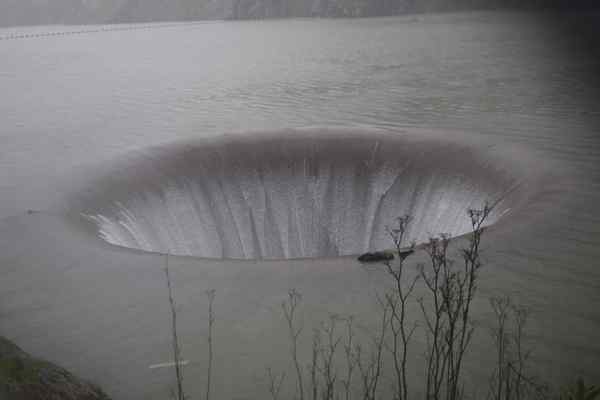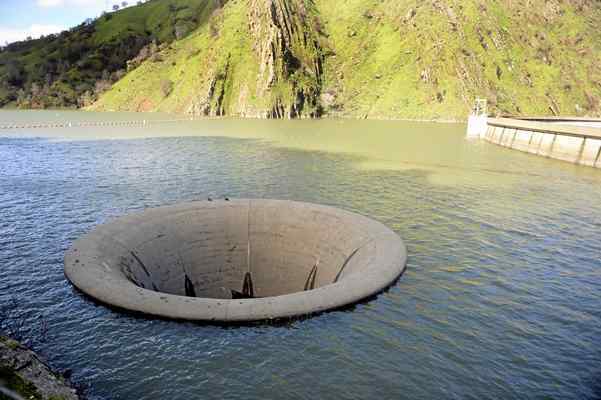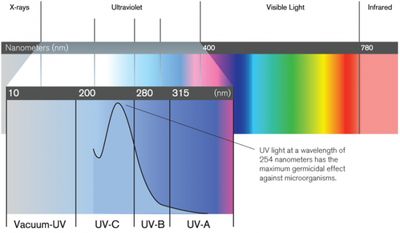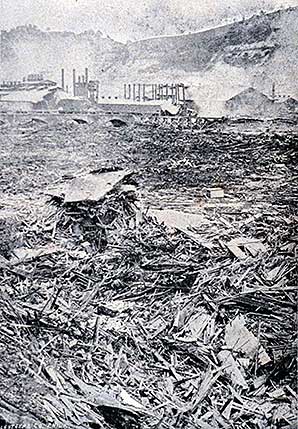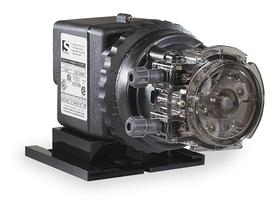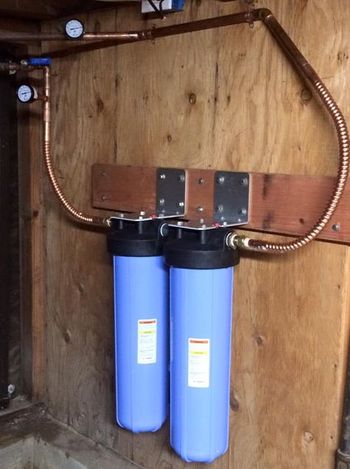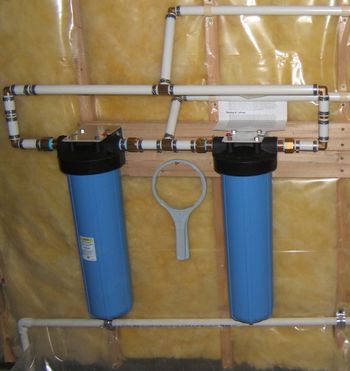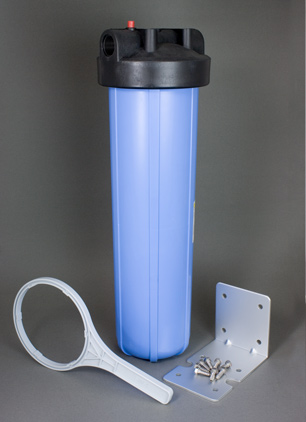In this pre-St. Patrick's Day Occasional, you'll hear about the Lake Berryessa Glory Hole, the South Fork Dam tragedy, the history of ultraviolet water treatment, and raising the pH of acidic water. Then there are calcite, corosex, peristaltic pumps, nanometers, compact whole house filters, very large whole house filters, and good old Niels Fensen. You'll hear about ongoing water litigation, plans to restore reservoir capacity, the use of leaking ponds to save water, the recycling of urine as fertilizer, the encouraging recovery of Lake Mead, and, as always, there is much, much more. |
|
 |
Pure Water Occasional for February 14, 2017
The full email Occasional is no longer archived online, but most of the individual articles can be found on the Pure Water Gazette's website. Read the Gazette every day for the latest news from the world of water.
|
Gazette’s Famous Water Picture Series: The Lake Berryessa Glory Hole
Lake Berryessa Glory Hole
Lake Berryessa is the largest lake in Napa County, California. The reservoir in the Vaca Mountains is formed by the Monticello Dam, which provides water and hydroelectricity to the North Bay region of the San Francisco Bay Area.
What you see in the picture is the dam’s spillway, which because of California’s drought had not overflowed for a long, long time. After a drought-ridden 10-year period, in February of 2017 water finally spilled into Lake Berryessa’s Glory Hole, bringing an end to the longest gap between spills in the lake’s history.
The Glory Hole is near the dam on the southeast side of the reservoir. It is an open bell-mouth spillway, 72 feet in diameter. The pipe has a straight drop of 200 feet, and the diameter shrinks down to about 28 feet. The spillway has a maximum capacity of 48,000 cfs (cubic feet per second). One cubic foot per second is about 450 gallons per minute, so the Glory Hole’s capacity to drain the lake is about 21 million gpm. The spillway operates when there is excess water in the reservoir. In 2017 after heavy rains it started flowing, for the first time since 2006.
In 1997 a woman was killed after being pulled inside the spillway.
The Glory Hole when it isn’t overflowing
History of Ultraviolet Water Treatment
Although UV has other applications in water treatment, such as chloramine reduction, by far the most common use is for germicidal disinfection. As the picture illustrates, the standard UV dosage for germicidal treatment is 254 nanometers.
Although it has taken a long time for the technology to become widely adopted, UV has been around for a long time. In 1877, the germicidal properties of sunlight were discovered and it was only a matter of time before people tried to apply this knowledge for practical use. In 1903, Niels Fensen received a Nobel Prize for his use of ultraviolet light to combat tuberculosis, and in 1910, the first drinking water disinfection system opened in Marseilles, France.
From that time, the technology changed very little until the 1930s, when the first tubular lamps were developed. The tubular lamp allowed for easier applications and different configurations for use.
In the 1950s, the first truly significant research into UV disinfection began. By the 1960s, UV disinfection was becoming more widely used in commercial applications and was creeping into the residential market.
Today, ultraviolet disinfection is widely accepted as an effective treatment for the removal of microbiological contaminants from water. Although it was initially viewed as a treatment for un-chlorinated well water, the use of UV for city water residential applications is increasing rapidly. As the infrastructure that cities use to deliver water to customers deteriorates, point-of-entry UV is expected to become a standard feature in homes.
Even highly chlorine-resistant microbes such as Giardia and Cryptosporidium can be effectively eliminated from water with UV. UV systems are becoming an increasingly popular alternative to chemical treatment for many applications.
Are US Dams Safe?
Dam disasters have been rare but spectacular.
The recent scare at the Oroville Dam in California has brought dam safety to public attention. The following is adapted from a piece by Jeremy P. Jacobs.
The catastrophic failure of the South Fork Dam in 1889 killed more than 2,200 people in Johnstown, Pennsylvania.
There have been many U.S. dam failures. And some have been catastrophic.
In May 1889, the 72-foot-tall South Fork Dam on western Pennsylvania’s man-made Lake Conemaugh gave way, unleashing a 40-foot wall of water that hit the city of Johnstown, nearly 9 miles away. More than 2,200 people were killed–that’s 1 out of every 5 Johnstown residents.
And in California, the St. Francis Dam was considered an engineering feat in Los Angeles County until it failed in 1928, killing as many as 400 people.
The Baldwin Hills Dam, also in Los Angeles, gave way, killing five in 1963. In 1976, the Bureau of Reclamation’s Teton Dam in eastern Idaho collapsed, killing 11 and causing more than $1 billion in property damage.
The most recent dam failure to cause a fatality occurred in 2006, when the earthen Ka Loko Dam in Kauai, Hawaii, breached, killing seven people.
Some experts caution against making too much of the number of fatalities linked to dam failures.
Martin McCann of Stanford University’s National Performance of Dams Program said that since the 1850s, dams have killed probably a little more than 4,000 people — a large number, but one that pales in comparison to auto accidents, for example.
“If your argument were to be based on body counts, crocodiles and deer running on highways might beat out dams,” McCann said.
He noted that dam inspections and state and federal authorities have improved, especially since the 1970s when fatalities from dam failures peaked at more than 450 in the decade.
“It’s not black and white. Do we have a lot of dams that pose a risk to the public? Yeah, we do,” he said. “Are they all in terrible shape? Not even close.”
Raising the pH of Acidic Water
Let’s be clear. This article is not about “ionizers” or similarly misnamed consumer gadgets that magically amend the pH of water and contribute to the health, wealth, and happiness of the seller.
It is about the standard strategies used by water treatment professionals to raise the pH of acidic waters, most often well water, for aesthetic improvement, the protection of plumbing fixtures, or to assist in other water treatment procedures such as the removal of iron and manganese.
The calcite filter above has a "dome hole" on the side near the top to allow fresh calcite to be added to the tank without removing the head. Calcite and Corosex (also sold as Mang Ox) are "used up" in the process of pH correction and have to be replenished occasionally.
Two standard techniques are used to raise pH: filtration and injection.
Filtration involves sending the water to be treated through a bed of a granular sacrificial medium which dissolves slowly and adds calcium carbonate to the water, thus buffering the acidity and raising the pH. The most commonly used medium for this process is calcite—a natural granular substance that provides a relatively mild upward bump in pH. Calcite is sometimes mixed with a smaller amount of another standard medium called Corosex which adds magnesium to the water and has a stronger effect on increasing pH.
Most filters for acid neutralization are backwashing filters, like the one pictured, but if the water is very clean—such as in post-treatment for large reverse osmosis units—in/out style upflow filters can be used. (Calcite is also available in cartridge form for post treatment for undersink reverse osmosis units.)
The only disadvantage of calcite treatment is that it raises the hardness of the treated water slightly. This is of no concern unless the water being treated is already very hard.
The second standard pH increase strategy is injection of a small amount of a pH increasing substance into the water stream.
The small "peristaltic" pump injects sold ash or caustic soda into the water line to raise pH. It can also be used to inject an acid like vinegar or citric acid to lower the pH of very alkaline water.
Soda Ash is the most commonly used pH increaser, but a product called caustic soda, which is about a 30% stronger pH increaser, is sometimes preferred, especially in swimming pool treatment.
Soda ash is delivered via a small injection pump, usually electric, that injects a solution of the product under pressure into the water line.
The advantage of injection of soda ash is that it does not add to hardness and it gives a more potent increase in pH. It can be used to treat water in the 5.0 range, whereas calcite filtration does not give sufficient increase to very acidic water.
|
Current Water News
Water Litigation
In the ongoing state vs. state water wars being waged in the courts, Georgia won a major decision over Florida and Texas won over New Mexico. Both cases involve the right to water in rivers that pass through both states.
In a more complex litigation about water, the Trump administration (as did also the Obama administration) is asking a federal court to dismiss a lawsuit by New Mexico and the Navajo Nation over a 2015 mine-waste spill caused by the Environmental Protection Agency (EPA) at the abandoned Gold King Mine in Colorado. There are 1.2 billion in claims, and the government is denying responsibility because the agency was simply aiding in cleanup caused by operators of the mine. Republicans earlier slammed the Obama administration for taking the same stance as the current administration.
The 2015 spill was caused by an EPA contractor who, working with federal and state employees, miscalculated the pressure of wastewater at the abandoned mine. About 3 million gallons of toxic sludge spilled out, turning the Animas River orange for days, along with downstream rivers that run through New Mexico and the Navajo Nation’s reservation.
New Mexico has also sued Colorado in the Supreme Court over its alleged responsibility for the spill. The high court is considering whether to hear that case.
The Complexity of Water Management
President Trump recently commented with some surprise that health care is a "complicated issue." His administration is in the process of figuring out that water management is also a very complicated issue and that it will take a lot more than a showcase signing of an executive order to cancel the "Waters of the United States" policy. Changing a significant water rule can take years and involve hard-fought political battles and even renegotiating international treaties. Water is an international commodity and, as John Muir might say, when you alter one part of a policy, you alter dozens of things "downstream."
Other Water News
New York city’s need for water infrastructure upgrade is expected to cost $80 over the next 20 years.
Oklahoma is considering joining the practice of several other states of storing water underground by using “leaky ponds” to recharge aquifers. Rather than allow surplus water to leave the state as runoff to rivers or to be stored in lakes subject to loss by evaporation, water is redirected to aquifers to be pumped to the surface in times of need.
Good News for Lake Mead, and Consequently Las Vegas: Federal forecasters now expect the Lake Mead reservoir to avoid its first federal shortage declaration next year, thanks to the boost it should get from what could wind up as the wettest winter on the river’s basin in 20 years. Storms in Utah, Colorado and Wyoming over the past month have added more than 3 million acre-feet to the water supply forecast for the Colorado. That’s a 10-year supply for Nevada, which gets 300,000 acre-feet from the river each year.
There is a rather extensive research project going on at the University of Michigan that is designed to find the most effective ways to convert urine into fertilizer that can be used to help plants grow. Urine is rich is nitrogen, phosphorous, and potassium. The current phase of the project features uses of a special toilet that harvests fertilizer ingredients from human urine.
Although reservoirs are seldom thought of as part of the water infrastructure that needs maintenance, water managers are catching on that many of the nation’s reservoirs are operating at a fraction of their original capacity because they are filling with silt, sand and gravel. Evidence is growing that cleaning the debris out of our reservoirs to restore their holding capacity makes more sense than searching for new sources of water by building dams and drilling more wells.
|
Compact Whole House Cartridge-Style Filter Installation
Compact Whole House Filters Installed in Series. Water passes through the sediment filter and then through the carbon block filter.
An extremely versatile product, Pure Water Products' Compact Whole House Filters can be installed in series, as shown above, or in parallel, as shown in the picture below.
Parallel Installation gives double the flow rate potential. Two cartridges capable of handling 7 gallons-per-minute each become a 14 gallon-per-minute filter when the water line is split so that each filter handles half the flow.
As the pictures show, even our multi-filter systems are sold for mounting on single brackets. This is a great advantage for the installer. The flow can be directed either right to left or left to right, the bracket can be pointed up or down, and multiple units can even be installed in separate locations, when space is tight. The filters can also be installed either in series (first picture) or in parallel (second picture).
The "20 inch Big Blue" housing accepts 4.5" X 20" cartridges, a standard size, so many filtration options are available. The housing works with radial flow cartridges, where water flows from the outside of the cartridge to the center (carbon block and sediment filters) or axial flow cartridges, where water flows the full length of the cartridge from bottom to top ("media" cartridges with granular carbon, iron removal media, KDF, softening resin, pH amenders, etc.).
The Pure Water Products Compact Whole House Filter comes with housing, one filter cartridge, mounting bracket with screws, and a filter wrench for cartridge replacement.
Typical applications of this filter are for whole house city water treatment of sediment, chlorine, chloramines, taste/odor, and extraneous chemicals, or well water treatment of sediment, low pH, iron, manganese, odors, and scaling.
Compact units are easy to install, needing no drain or electrical connection, inexpensive, and versatile. The standard pipe size is 1", but they are available also in 3/4" and 1.5" sizes.
Big Backwashing Filters: Filters with a 4" Top Hole
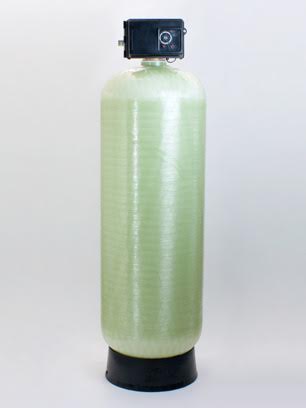
Fleck 2850 Filter, 21″ X 62″. Will support a service flow of up to 50 gallons per minute.
Most residential backwashing filters have 2.5″ threaded top holes in the mineral tank. Conventional “small” filter valves like the Fleck 5600, Fleck 2510, and Fleck 5810 screw into 2.5″ top holes. These control valves can be used on tanks up to 13″ in diameter.
Beginning with 14″ tanks, most tanks have 4″ top holes and require the use of larger filter valves, like the Fleck 2750, 2850, or 3150. Tanks with 4″ holes are available up to 24″ X 72″ in size. (The next larger size of tanks have a 6″ flange connection on top rather than a threaded hole.)
For want of better name, we call the filters made with the second size top hole 4″ filters. The filter above is from this group.
In general terms, filters of this size are for use in situations needing flow rates above 10 gallons per minute. We have a large range of filters ranging in price from $985 to $4225, with media sold separately.
We currently offer 4" top hole filters with several types of carbon (standard bituminous, coconut shell, catalytic) for treatment of chlorine, chloramine, iron, and hydrogen sulfide. Also iron removal systems with Birm, Katalox Light, and Filox, and sediment filters with ChemSorb, Filter Ag, and Multi-Media (sand, garnet, anthracite).
|
Please visit our RO Parts Page for tanks and accessories. We also have dedicated parts pages for countertop water filters, undersink filters, and aeration equipment. We stock parts for everything we sell.
Thank you for reading. Please come back next week.
Places to Visit on Our Websites:
Garden Hose Filters. Don’t be the last on your block to own one. And don't forget that National Garden Hose Day is always less than a year away.
Model 77: “The World’s Greatest $77 Water Filter”
Please Visit
|
|
|
|
